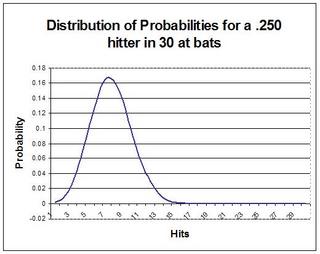As seemingly happens every post season the discussion about clutch performers comes to the forefront. The excellent performance of the Astros Chris Burke (now affectionately called Chris "Burke-tober" by his hitting coach Gary Gaetti) has only magnified the usual discussion.
So it was no surprise that in this morning's Denver Post was an article titled "Clutch? It's succeeding in bright lights" where reporter Tony Renck talks about the different definitions of clutch from various player's perspectives that fall into the camps of consistency and timing.
One comment I thought was interesting, and that betrays a lack of understanding about the nature of variability, was Lance Berkman's view that:
"The way I see it, if you hit .330 during the regular season, then you need to hit .330 in the playoffs...You can't expect a guy who batted .250 all year to suddenly hit 100 points higher."
What's wrong with Berkman's view is that it fails to take into account the variability involved in an activity like hitting at the major league level. In a single post season a player gets at most 80 at bats and with such a small sample size there is a great deal of variability in any player's performance even if you know what their true ability is. For example, using a standard binomial distribution a .250 hitter will hit over .250 fully 42% of the time and between .300 and .350 more than one time in 10 (11%).
Of course in actuality most hitters who get "hot" in the post season do so in a particular series. In a seven game series a .250 hitter would hit between .300 and .367 almost 15% of the time. Below is the distribution of those probabilities for a .250 hitter over 30 at bats.
You'll notice that there is significant space under the curve to the right of the 8 on the x-axis which represents a .267 average over 30 at bats.
The fact that Alex Rodriguez went 2-15 in the Division Series represents nothing more than natural variation and a result that was not unlikely.
Sunday, October 16, 2005
The Probability of Chris Burke-tober
Posted by
Dan Agonistes
at
5:55 PM
![]()
Subscribe to:
Post Comments (Atom)

125x125_10off+copy.jpg)



No comments:
Post a Comment